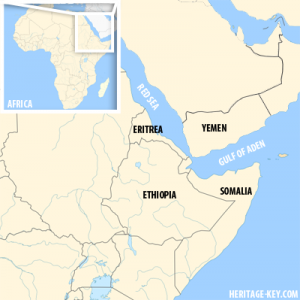 Throughout their history the ancient Egyptians recorded making voyages to a place called the ‘Land of Punt’. To the Egyptians it was a far-off source of exotic animals and valuable goods.
Throughout their history the ancient Egyptians recorded making voyages to a place called the ‘Land of Punt’. To the Egyptians it was a far-off source of exotic animals and valuable goods.
From there they brought back perfumes, panther skins, electrum, and, yes, live baboons to keep as pets. The voyages started as early as the Old Kingdom, ca. 4,500 years ago, and continued until just after the collapse of the New Kingdom 3,000 years ago.
Egyptologists have long argued about the location of Punt. The presence of perfumes suggests that it was located somewhere in Arabia, such as Yemen. However the depiction of a giraffe, at a temple built by Queen Hatshepsut, tells archaeologists that Punt is likely somewhere in Africa – perhaps around Ethiopia, Eritrea or Somalia.
There are even suggestions that it could be further south on the African coastline, perhaps as far as Mozambique.
The surviving Egyptian texts give only vague references to its location. An example below records a voyage sponsored by the Pharaoh Ramesses III. Author Pierre Grandet wrote:
I built great ships … which were equipped with countless crewmen. Laden with products beyond number from Egypt … (and then) sent to the great Sea of Muqed, they reached the mountains of Punt without any misfortune befalling them.
Finding Punt
To solve the mystery of where Punt was, a team of scientists is turning to two mummified baboons in the British Museum. They date back about 3,000 years, a time when Egyptians were voyaging to Punt and acquiring the animals as pets.
One was found at Thebes and the other in the Valley of the Kings.
 The team is conducting oxygen isotope tests on the preserved hairs of the baboons. Oxygen isotopes act as a ‘signal’ that can tell scientists where an animal is from.
The team is conducting oxygen isotope tests on the preserved hairs of the baboons. Oxygen isotopes act as a ‘signal’ that can tell scientists where an animal is from.
“We have hair samples from the older mummified ones in the British Museum and depending on how the results look the curators are willing to give us bone samples,” said Nathaniel Dominy of University of California Santa Cruz, who is a member of the team doing the work.
He said that bone is better for this test than hair because it grows slower and keeps its original oxygen isotope signature longer.
To aid in narrowing down the location of Punt the team is also performing oxygen isotope tests on samples of modern day baboons from Eritrea, Ethiopia, Somalia, Yemen, Uganda and Mozambique. If the oxygen isotope signatures of these baboons match their ancient counterparts the team will know where Punt was.
The other team members are Professor Salima Ikram, one of the foremost experts on animal mummies, and graduate student Gillian Leigh Moritz, also of Santa Cruz.
The Risks
“There’s a little bit of risk with this project,” Professor Dominy said.
He explained that the Egyptians were importing baboons from Punt to keep as exotic pets. This poses a problem since the longer an animal stays in Egypt and consumes the local diet, the more its oxygen isotope value changes.
“There’s a little bit of risk with this project”
There are only two baboon samples available to the team. If they were both kept as pets in Egypt for a long period of time the scientists may not be able to get the data they need.
Hair grows fast and in a year or so “the chemical signal associated with their origin will be completely obliterated,” said Dominy. Bone is a possible fallback option because it grows slower than hair and the ‘signal’ stays in it longer.
There is one other possible problem.
Even if the team gets the data, successfully honing in on the precise origin of the animals could still be tricky. Baboons from areas that are close to each other tend to have similar oxygen isotope signatures making it a challenge to figure out exactly where they are from.
Baboons of the Ptolemies
The team will also be analyzing the hair of baboons that date from the Ptolemaic Period. This is a time in Egypt’s history that runs from its conquest by Alexander the Great in 332 BC, to the death of Cleopatra in 30 BC.
The team will be using baboons from the Petrie Museum in University College London. While this work will tell archaeologists where the Ptolemies were getting their baboons, it isn’t likely to reveal the location of Punt. “The New Kingdom expeditions to Punt had largely diminished by that point,” said Dominy.
If all goes well the team hopes to have some initial results by April 23 – the start of an academic conference being held by the American Research Center in Egypt (ARCE). Professor Dominy said that these first results may not yield the location of Punt but “at minimum we can reject some places.”